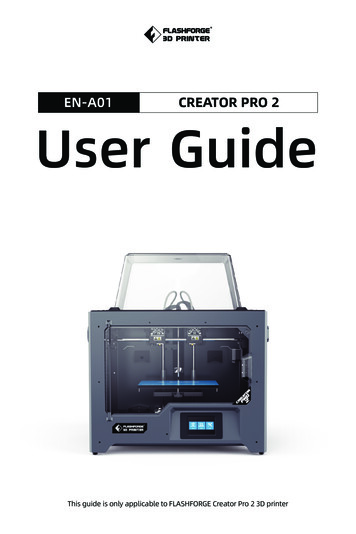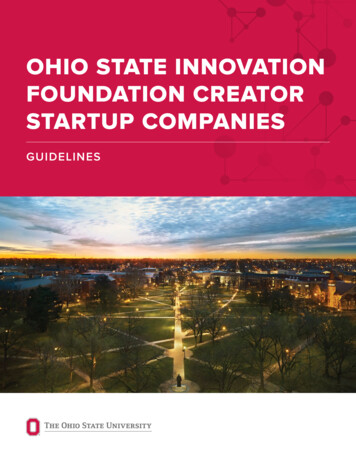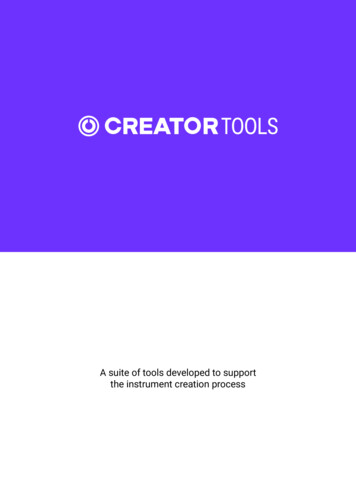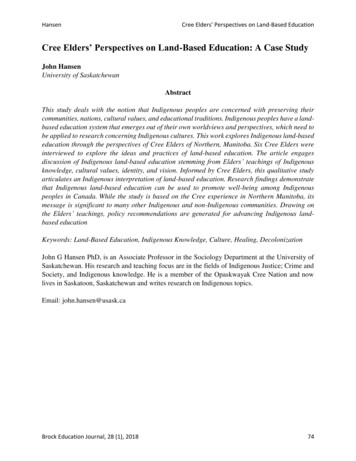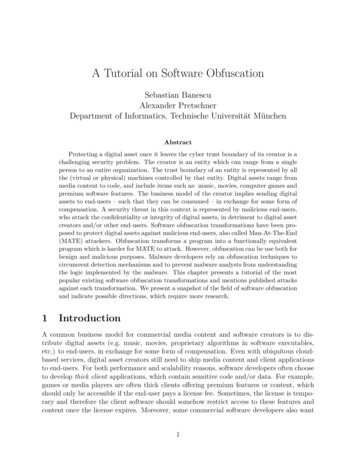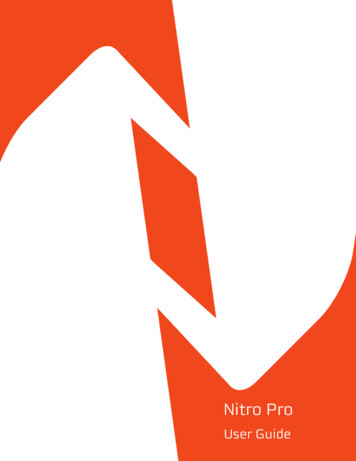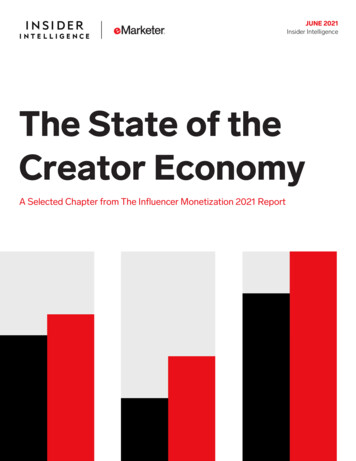
Transcription
JUNE 2021Insider IntelligenceThe State of theCreator EconomyA Selected Chapter from The Influencer Monetization 2021 Report
IntroductionThank you for downloading “The State of the CreatorEconomy,” curated by Insider Intelligence Marketing. Thefollowing is an excerpt from the full “InfluencerMonetization 2021” report. In this excerpt we detail thelatest trends in the creator economy, includingmonetization strategies, popular social platforms, andrecent growth.Creators Are a Serious BusinessMany marketers long underestimated the value ofcreators in their marketing mix. That’s no longer thecase. Most brands today have incorporatedinfluencer marketing into their media plans, and manyintend to allocate even more budget to the tactic thisyear than they did previously.According to our latest forecast, 67.9% of US marketers fromcompanies with 100 employees or more will use influencermarketing in 2021, up from 62.3% last year. In 2022, thatfigure will rise to 72.5%.Share of US Marketers Using Social Media andInfluencer Marketing, 2019-2022% of total marketers91.0%72.5%62.3%55.4%2020Social media marketingIn our previous reports, we used the words “influencers”and “creators” interchangeably. But as the influencermarketing space evolves and expands, so too must thevocabulary used to refer to the individuals who are activein it.The traditional definition of an influencer—an individualwho can sway the buying preferences of a largerpopulation—can refer to a wide variety of people, fromemployees and industry professionals to celebrities andloyal customers. In that sense, creators are a subset ofinfluencers.In this report, we define creators as people or entities thatdevelop original content for digital properties, and whoconsider creating that content to be either their full-timeor part-time career or livelihood.Of course, there is some overlap between many of thesegroups; for instance, celebrities can also be creators andvice versa. What’s more, few successful influencers todayare purely sales-oriented, and many of them are alsocreators, developing digital or, at times, physical products.For that reason, this report will use the term “creators”exclusively to refer to the individuals in the influencermarketing space, unless it’s within a direct quote from anexpert we interviewed or from a third-party data provider.We’ll still use the term “influencer marketing” whendiscussing our forecasts or describing the general practiceof engaging individuals to create sponsored content,however.92.1%67.9%2019Creators vs. Influencers91.9%91.7%20212022Influencer marketingNote: companies with 100 employees; includes both paid and unpaid (i.e., compensationin the form of free product or trips) brand-influencer partnershipsSource: eMarketer, Nov 2020262207eMarketer InsiderIntelligence.comThe pandemic has played a major role in driving wideradoption of influencer marketing. After an initial pause inspending in H1 2020, marketers quickly resumed and evenincreased spending, as budgetary constraints and studioclosures curtailed traditional ad production.According to an analysis of 3.5 million Instagram posts byvisual marketing platform Later and influencer marketingcompany Fohr, the average monthly number of sponsoredposts between April 2020 and June 2020 was down by42.9% year over year (YoY). By December, however, thatfigure had bounced back, with the number of sponsoredposts that month up by over 20% YoY.For more on how the pandemic has changed influencermarketing, see our August 2020 report, “InfluencerMarketing in the Age of COVID-19: How Brands andCreators Are Adapting to a ‘New Normal.’”And marketers will continue to rely on influencer marketingbecause the pandemic accelerated many longer-termshifts within the social media landscape, including socialcommerce, livestreaming, and short video, and led to the riseof new trends like social audio. Those are all creator-drivenactivities, and brands are beginning to understand thatcreators are their ticket in.Copyright 2021, Insider Intelligence Inc. All rights reserved.Page 2
“Social commerce in particular has made influencersvery powerful,” said Stacy DeBroff, founder and CEO ofinfluencer marketing platform Influence Central. “Thenthere are the new platforms, like Clubhouse or TikTok. Theyhaven't figured out their ad strategy yet, and brands arerealizing that influencers are their best conduits for reachingthose audiences.”In a March 2021 survey by influencer marketing platformLinqia, 68% of US marketers said they were planning touse TikTok for influencer marketing, up from just 16% inFebruary 2020. That made TikTok the third most popularformat measured, behind only Instagram (93%) andInstagram Stories (83%). The share of marketers whoplanned to use Twitch also more than doubled, going from5% to 13% in the same time frame.Which Social Media Platforms Are US MarketersPlanning to Use for Influencer Marketing?% of respondents, Feb 2020 vs. March 2021Feb 2020March 2021Instagram % %Instagram Stories % %TikTok ˆ%ˆ %Facebook %ˆ %YouTubeˇˇ%ˇ %- ˆ%Instagram ReelsPinterest %35%Twitter35% %Snapchat ˆ% ˆ%Blogs ˇ%TwitchChange in Influencer Marketing SpendingAccording to Marketers Worldwide, Jan 2021% of respondentsIntend to increase their influencer marketing budget62%Expect to keep their budgets the same as in 202020%Unsure about how their influencer marketing budgets would change12%Intend to decrease their influencer marketing budgets7%Source: Influencer Marketing Hub in association with Upfluence, "Influencer MarketingBenchmark Report: 2021," Feb 15, 2021264224And a November 2020 survey by Advertiser Perceptionsfound that influencer and other paid content will represent20% of US agency/marketing professionals’ digital adbudgets in 2021, ahead of paid search (14%), displayadvertising (13%), and even paid social and video(eachat 12%).Share of US Agency/Marketing Professionals' 2021Digital Ad Budgets, by Format, Nov 2020% of totalOther*29%25%5%eMarketer InsiderIntelligence.comPaid content/influencers20% %Paid search14%Source: Linqia, "The State of Influencer Marketing 2021," April 20, 2021265702eMarketer InsiderIntelligence.comVideo12%For more on how the pandemic-driven online shopping boomhas propelled social commerce, read our February 2021 report,“Social Commerce 2021: Media and CommerceConvergence Creates Growth Opportunity for Brands.”Spending on influencer marketing is also up. According toJanuary 2021 research by Influencer Marketing Hub andinfluencer marketing platform Upfluence, 62% of marketersworldwide said they intend to increase their influencermarketing budgets this year. One-fifth expected theirinfluencer budgets to remain the same as in 2020, while just7% expected their budget to decrease.Paid social12%Display13%Note: n 205; *connected TV (CTV)/OTT (8%), ecommerce (7%), in-app (6%),audio/podcasts (6%), other digital (3%)Source: Advertiser Perceptions, "Branded Content and Influencer Marketing Report" as citedby MediaPost, April 27, 2021265745eMarketer InsiderIntelligence.comAt the same time, however, the creator economy isexpanding, adding new or improved opportunities forcreators to make money outside of brand partnerships.That’s creating tension across the influencermarketing landscape.Copyright 2021, Insider Intelligence Inc. All rights reserved.Page 3
“Influencers have more ways than ever before to makemoney, and they’re having to do arbitrage on whereto spend their time and where to place real estate,”said Pierre-Loïc Assayag, founder and CEO of influencermarketing platform Traackr. “It reminds me of the beginningof social media when there was this enthusiasm for anythingand everything, and the platforms are behind a lot of that.”Platforms Where Teens/Adults in Germany, the UK,and the US Engage with Influencers, Sep 2020% of %SnapchatThe Competition for CreatorAttention Is Creating NewMonetization Options14.5%TikTok14.2%Twitch7.7%Like many marketers, the social companies haven’talways taken creators seriously. That’s now changed.Triller1.7%Don't use social media platforms to engage with influencer content“Except for YouTube and maybe Instagram, the socialplatforms have long had this mindset that creators are nodifferent from any other user,” said Eric Dahan, co-founderand CEO of influencer marketing company Open Influence.“But all the platforms now understand that creators area key part of their services. Add in competition fromnew social apps, and it’s triggering a battle for creators.As part of that, creators get tools to monetize.”Case in point: Clubhouse. In its first monetization move, itintroduced Payments, through which users can send moneydirectly to hosts on the platform. Clubhouse isn’t taking acut; 100% of the money will go directly to the creator. Thatfollowed the launch of its Creator First accelerator program,which pays participating creators a monthly stipend andhelps match them with brands for sponsorships.For more on Clubhouse and how marketers can make themost of social audio, see our April 2021 report, “Clubhouseand Social Audio Trend: Straight Talk About When andHow Marketers Should Get Involved.”As of now, YouTube and Instagram continue to have astrong lead in the battle for creators. In a September 2020survey by influencer marketing agency Takumi, 47.3% ofteens and adults ages 16 and over in Germany, the UK, andthe US said they engaged with influencers on YouTube.Over one-third (36.9%) said they engaged with them onInstagram, compared with 17.3% for Pinterest and just over14% for Snapchat and TikTok.31.7%Don't have social media8.4%Note: n 3,010 ages 16 Source: Takumi, "Into the Mainstream: Influencer Marketing in Society," Sep 30, 2020262785eMarketer InsiderIntelligence.comThe Creator Economy Is BoomingThe social platforms aren’t just battling each other forcreator attention, however. They’re also competing with amyriad of upstarts that all promise new ways for creators tomake money online, many of which have seen massivegrowth over the past year.“We’re just seeing the tip of the iceberg of the creatoreconomy,” said Ricky Ray Butler, CEO of BEN Group. “It’sgrowing faster than it’s ever grown before, and there arealso more creators now than ever before. That opens thedoor to a lot of opportunity and even more decentralizationof content.”A May 2021 report by early-stage venture capital firmAntler, for example, found that there are more than 220companies worldwide that cater to creators. Audiencemonetization was the largest category; Antler identified 85companies that help creators make money outside of brandsponsorships. Other categories included creator tools (48companies), audience curation (44 companies), verticalplatforms (32 companies), and community management (27companies).Copyright 2021, Insider Intelligence Inc. All rights reserved.Page 4
50 millionHere are some examples: Cameo: Launched in 2017, Cameo is an app that allowsconsumers to pay celebrities, athletes, and social mediastars to create personalized videos. Creators set theirown prices that can range from as little as 1 per videoto thousands for popular celebrities. According to datafrom Apptopia cited by Axios, the number of Cameodownloads increased by 134% between January 2020and November 2020. NewNew: The app describes itself as a “human stockmarket” and allows fans to control creators’ decisions.Creators can post polls asking questions ranging fromthe trivial (“Which sandwich should I have for lunchtoday?”) to the more concrete, like a beauty creatorasking for advice on which shades to include in anupcoming eyeshadow palette. Fans pay to vote in thepolls, and creators are supposed to perform whichevertask garners the most votes. The app is currently in betatesting with a limited number of creators. Patreon: Established in 2013, Patreon provides abusiness infrastructure for creators to showcasetheir content. Fans pay creators directly for access,and the company takes a 5% to 12% fee from thosesubscriptions. According to The Wall Street Journal,Patreon is now valued at 4 billion, up from 1.2 billionin September 2020. Substack: Launched in 2017, Substack is a servicethat allows writers to create and send paid newslettersto subscribers. Substack collects 10% of subscriptionrevenues from its users, and its payment provider,Stripe, takes another 2.9% plus a 30-cent transactionfee. As of January 2021, Substack said it had more than250,000 paying subscribers, and its top 10 publishersbrought in more than 7 million in annual revenues.people worldwide consider themselvesto be creators.SignalFire, late 2020The pandemic played no small role in the growth of theseplatforms. As brands tightened their purse strings in theearly months of 2020, many creators were forced to find newways to make money.In a September 2020 survey by influencer marketingplatform Mavrck, for example, 80.8% of US adult influencerssaid they had felt the need to seek out alternative incomeopportunities. That figure remained relatively stable, at79.8%, in April 2021.Have US Influencers Felt the Need to SeekAlternative Income Outside of Campaign Workwith Brands?% of respondents, April 2021No20.2%Yes79.8%Source: Mavrck, "Creator Pulse Survey," April 29, 2021265750eMarketer InsiderIntelligence.comWhile all of the creator economy platforms are different,their value propositions are the same: They are centeredaround creators and are aimed at helping them make moneyor manage their businesses. That’s in contrast with thetraditional social networks, which are primarily powered byordinary users’ organic interactions, and where creators arejust one part of a larger marketing ecosystem.Copyright 2021, Insider Intelligence Inc. All rights reserved.Page 5
Power your next move withclear and credible insights.Insider Intelligence Subscriptions: The Fastest Path to InsightAll Insider Intelligence research is available to our clients via an Insider Intelligencesubscription. The subscription provides access to all Insider Intelligence analyst reports,forecasts, daily briefings, signature charts, interviews, case studies, webinars and more.See for yourself how easy it is to find the insights you need.Learn more about our subscriptionsThis is a preview of one Insider Intelligence report.Insider Intelligence reports highlight the latest information on a given topic, includingdata-packed charts and qualitative insights, to keep our clients at the forefront of the mostcritical consumer trends.Browse our reports hereCoverage of a Digital WorldInsider Intelligence provides data and insights into industries’ digital leaders and mosttransformative technologies, as well as how their target consumers are spending their timeand money.Explore recent Insider Intelligence coverageSchedule a DemonstrationGo to insiderintelligence.com or email ii-sales@insiderintelligence.com to get a personalizeddemonstration or request a quote today.Copyright 2021, Insider Intelligence Inc. All rights reserved.Page 6
Case in point: Clubhouse. In its first monetization move, it . introduced Payments, through which users can send money directly to hosts on the platform. Clubhouse isn’t taking a cut; 100% of the money will go directly to th
